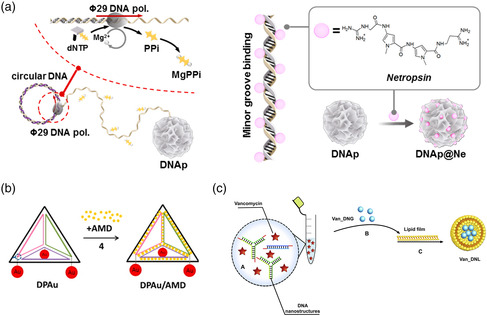Figure 5.

Strategies for the transport of antibiotics to bacteria by DNA nanostructures. a) The DNA‐binding antibiotic molecule netropsin is loaded into DNA “nanoflower” objects that are formed from a rolling‐circle PCR reaction. Reproduced under the terms of the Creative Commons Attribution 4.0 license.[ 104 ] Copyright 2019, The Authors. b) The antibiotic actinomcycin D intercalates dsDNA and is loaded onto rigid DNA‐based tetrahedron structures. The additional attachment of gold NCs enables concurrent microscopic tracking of the nanostructures. Reproduced with permission.[ 106 ] Copyright 2014, American Chemical Society. c) The positively charged glycopeptide antibiotic VAN is encapsulated within compact “DNA nanogels” formed from the polymerization of small y‐shaped and linear dsDNA monomers. The VAN‐loaded nanogels are surrounded by a protective lipid bilayer to ensure stability in physiological environments. Reproduced with permission.[ 107 ] Copyright 2020, Elsevier B.V.
